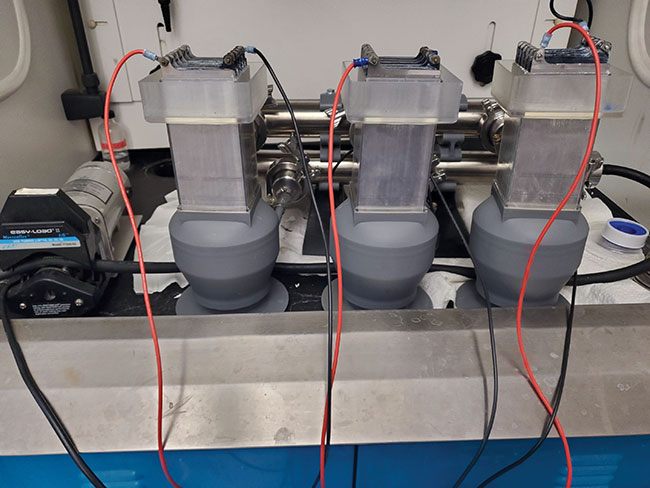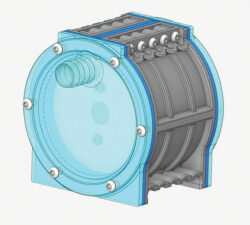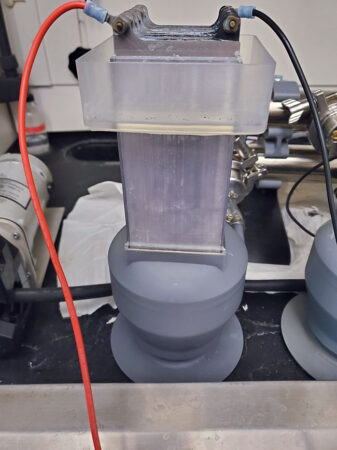
Features
Structures & Equipment
Water and irrigation
Hangover-free water treatment for CEA
We can treat water, reuse it, and do it inexpensively, says Dr. Thomas Graham
December 15, 2023 By John Dietz
 A prototype of the Regenerative in situ Electrochemical Hypochlorination (RisEHc) system for recirculating hydroponic solutions.
Photo: Dr. Thomas Graham
A prototype of the Regenerative in situ Electrochemical Hypochlorination (RisEHc) system for recirculating hydroponic solutions.
Photo: Dr. Thomas Graham Recycling precious water for food production in spaceships, in greenhouses, and in vertical farming facilities, is challenging but becoming sustainable and more cost-effective.
Nearly 25 years ago, in 1999, the new Controlled Environment Systems Research Facility (CESRF) in Guelph, ON, took up the three big challenges of treating and recycling water in closed systems. It began looking for answers on how to grow plants in space, on the moon and Mars.
One challenge has been solved, in principle, and a second is ‘close’ to a solution. The toughest challenge probably will take a few years yet, according to one of Canada’s leading controlled environment agriculture (CEA) scientists.
CESRF and its Space and Advanced Life Support Agriculture program are an essential part of Canada’s contributions to plant research and development for space and closed environment related activities.
Dr. Thomas Graham has recently (2019) transitioned into the leadership of the CESRF, as its founder Dr Mike Dixon takes on the role of Professor Emeritus, while maintaining Director duties for the facility at the University of Guelph School of Environmental Sciences. Addressing the 2023 Canadian Greenhouse Conference, Oct 9-10, at Niagara Falls, Thomas spoke about water treatment ‘without the hangover.’
Graham grew up in southwest Ontario, studied environmental and agricultural science at Guelph, and completed a NASA post-doctoral fellowship at the Kennedy Space Center before returning to Guelph in 2015 as Adjunct Professor and R&D Manager for Controlled Environment Systems Research Facility.
The facility today has at least 17 tightly sealed growth chambers where even air pressure and atmospheric composition can be varied along with heat, moisture, CO2 levels, and LED-based lighting (colour and intensity). It also has standard walk-in, not super-sealed chambers for conventional crop research. Technicians and up to a dozen graduate students continually work in the CESRF facility.
The sealed chambers at the CESRF are unique in that they can measure whole canopy photosynthesis and other key parameters in real time, returning gas exchange data (i.e., photosynthesis) in response to the application of whatever environmental recipe the researchers want to examine. The technology is incredibly useful for crop optimization studies and the technology continues to evolve. Numerous generations of chambers having been designed and built, both for internal use and for numerous international partners including Syngenta, the European Space Agency, and the German Space Agency, as the CESRF continues to evolve. The newest of these chambers, the PS2000, developed in collaboration with Intravision, a Canadian-Norwegian company, is just coming online and will continue the long tradition of advanced chamber design and use at CESRF. The team at CERSF are even in the process of designing such advanced chambers for use on the lunar surface, projects they collaborate with Canadensys Aerospace Corporation, and McGill University on.
“Although we have this suite of very high-fidelity, high-tech chambers, the number of chambers is still a bottleneck. We could build another hundred and probably still have them full all the time,” Graham says.
The technical carrot or challenge for the CESRF team is to ensure that astronauts have a reliable source of food, air, and clean water. Using space as the grand challenge, the team is immediately advancing Earth-based CEA systems.
“You’re trying to achieve complete closure of all the environmental loops, including water,” Graham said. “Technologies developed to do that are immediately transferable to Earth.”
Challenge #1 – Chlorination
Water quality control has been studied from the start. In a closed environment, maintaining quality water that is contaminant-free is critical for healthy plant growth.

A schematic of a ‘trial-ready’ electrochemical cell that, according to researchers, has excellent potential for decontaminating nutrient solutions in production systems that recirculate hydroponic solutions.
IMAGE: CESRF, Dr. John Phillips
Three main reasons stop greenhouses and vertical farms from reusing water forever: biological contamination (pathogens), chemical contaminants (there’s a laundry lists of these), and nutrient imbalances.
The focus at CESRF is on all three challenges, with emphasis on technologies that don’t require adding chemicals for the treatment process.
“I’ve looked at technologies such as ozone, UV light and heat, just to name a few,” he says.
Two electrochemical processes being developed by Graham’s team now have excellent potential for decontaminating nutrient solutions in production systems that recirculate hydroponic solutions. One is a chlorination process; the other is an advanced oxidation process.
The Regenerative in situ Electrochemical Hypochlorination (RisEHc) approach or system for recirculating hydroponic solutions has two parts, Graham explains. It begins with an electrochemical cell that is placed into the nutrient solution flow path. The cell has electrodes that drive reactions involving chloride ions already in the solution, to form hypochlorous acid – a highly effective disinfectant.
“It’s a bit of a process, but what is essentially trace or background levels of chloride is used as the raw material to electrochemically generate hypochlorous acid,” Graham explains. “The acid is an extremely effective disinfectant. It also reacts with some chemical contaminants to break them down.
“The regenerative part is that the chloride ion is liberated once the hypochlorous acid reacts with a pathogen or another chemical. The chloride then comes back to the electrodes and you generate more disinfectant. You never have to add more reagent; you generate it in the solution (in situ) that you’re treating.”
The other part of the process is in situ. It all happens in the fertigation stream or system. It can be in line, or in a bypass loop. “It’s cheap. You’re not having to buy or add anything, necessarily.”
He adds, “It’s not catalytic, but it’s the same effect. It remakes the product over and over with the same starting materials. With the right voltage and the right current density, things happen in a regenerative fashion.”
The process was discovered by grad student Serge Levesque in 2019. He was comparing UV and ozone oxidation technologies head-to-head, looking for a way to kill fusarium using electrodes in a nutrient solution. Results were published in HortScience in December 2022.
“The RisEHc chlorination system is primarily targeting disinfection, trying to keep the pathogens under control and, to a lesser extent, addressing the organic or chemical contaminants,” Graham says.
Water treatment normally requires the ongoing addition of reactants, like always adding bleach to purify the water. Whatever is added will likely accumulate over time and become a problem.
“That’s where the hangover comes from. If you add stuff to your system, not unlike adding alcohol to your body, it can be quite effective for a while, but eventually you get too much built up and there is a hangover to deal with,” Graham says. “Serge was just testing performance with some electrodes that weren’t part of the research program when he found that he was killing a lot of fusarium. The electrochemistry wasn’t new but how we package and manage the process in situ is new.”
Four years later, RisEHc is a well-tested and proven process ready to commercialize. Commercial field trials are needed at this point to deliver the technology to growers. The process is still chlorination, with many of the same limitations or caveats as traditional chlorination processes, the scientist notes.
“There’s no way around that, but it is a better mouse trap so to speak,” Graham says.

An electrochemical cell prototype developed by researchers at Controlled Environment Systems Research Facility (CESRF) in Guelph, ON.
Challenge #2 – oxidation
The CESRF team also has developed an Electrochemical Advanced Oxidation Process system (EAOP) that targets not only pathogens, but chemical contaminants that are difficult to breakdown with other technologies.
“Our other system kills bacteria and fungus as well, but it’s generating free radicals which are really good at breaking down recalcitrant (tough to breakdown) chemicals,” Graham says.
Details of this second issue solution are not ready to be released at this time, but Thomas expects that it will dovetail nicely with RisEHc as a more holistic treatment system approach.
He adds: “It will be a couple of years before this is commercially ready. It is just another tool, but it will be very inexpensive and there isn’t anything to break. There are no moving parts. There is lots of benefit to how we’re doing it, and you don’t have to manage or handle chemicals.
“At the end of the day, it is not new. How we’ve manipulated and managed it for controlled environment agriculture is new. It can certainly be used for field production, greenhouse production, or vertical farm production.”
The point is, if your closed system needs to capture and reuse water, you need to be able to treat that water effectively. Even when pulling water from a well or a municipal source, there is potential for contaminants.
Graham notes, we are surrounded by a ‘microbial rain’ so there is no avoiding the threat of plant diseases, but we can certainly greatly reduce that risk. One sick plant can slough off disease pathogens into water that is captured and recirculated through an entire facility. A sustainable process needs to keep it clean and fresh.
Challenge #3 – sensor technology
A lot of people are working on the third big challenge that runs in the background for all greenhouses and CEA environments. Perhaps the biggest roadblock for long-term nutrient recycling is our inability to measure the individual nutrients in [pseudo] real time.
“This is a tough nut to crack. It’s a technical challenge, it’s a sensor issue, ultimately. We don’t have any effective way, in even pseudo-real time, to measure the individual forms of all the fertilizer ions.” Graham says. “We can do it at our facility because we have a really expensive HPLC device and a technician to run it, but that’s just not feasible for growers.”
HPLC stands for high pressure (or high-performance) liquid chromatography. It is used in laboratory settings with expensive, high-quality components, to analyze the chemical components in a solution. Regular maintenance, calibration, and lab supplies are needed along with well-trained technicians.
In a long-term, closed growing system, ideally, operators need to know the concentrations of each and every ion, every day. Even a four-day wait for results from a lab with an HPLC is too long. By then, ratios have changed in the nutrient solution. He explains, the fertility regime in a nutrient solution changes daily as plants take up nutrients, and leave behind or slough off contaminants.
“Individual salt ratios change because plants feed and take up nutrients at different rates, on different days, under different environmental conditions,” Graham said. “We need sensors that can measure how much nitrate is in solution, how much phosphate (that’s the hard one), how much potassium, how much calcium, how much sulphur, how much for each of the other 12 to 16 essential nutrients. We’ve got a lot to measure in the field, and we’re not anywhere close to being able to do that yet.”
Growers can measure changes when fertilizer goes into solution by testing electrical conductivity and pH levels, but it’s a non-specific result. It’s been done for decades but tells them nothing about the individual nutrient concentrations.
“The sensor technology doesn’t exist to measure them all individually, certainly not in the complex soup that is the typical nutrient solution,” he says.
“There’s no silver bullet. We will need multiple subsystems within an overall water treatment system to crack this nut. If someone tells you otherwise, that there is a silver bullet, they’re wrong, plain and simple.”
Print this page